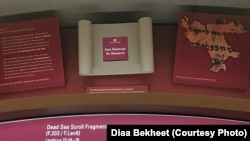One of the supposedly most valuable exhibits at the Museum of the Bible in Washington has turned out to be fake.
Experts have determined that 16 waxy yellow fragments said to be remnants of the Dead Sea Scrolls are not part of an ancient Hebrew Bible, but rather forgeries.
The real ancient scrolls were first found in 1947 in Qumran caves near the Dead Sea shore. They are considered to be one of the most significant historic discoveries of all time and are kept in Israel.
American billionaire Steve Green acquired the fakes about 10 years ago from private collectors to be one of the central exhibits in his Bible museum, which opened in 2017. Scholars were immediately suspicious of the authenticity of the scrolls, compelling the museum to submit the items for analysis by more than one appraiser. Evidence that the scrolls were not authentic led the museum to hire Art Fraud Insights for expert analysis that took six months and resulted in a 200-page report.
"After an exhaustive review of all the imaging and scientific analysis results, it is evident that none of the textual fragments in Museum of the Bible's Dead Sea Scroll collection are authentic," said the head of the investigation, Colette Loll of Art Fraud Insights.
Scientists have found that the collection of fragments was a set of deliberately made forgeries created in the 20th century with the intent to mimic the authentic Dead Sea Scroll fragments. The forgers have used mineral surface deposits consistent with Middle East archeological digs and used small scraps of ancient leather, coated with an amber material to create a surface with the appearance of ancient parchment.
Investigators have also determined that the ink used on the fragments did not match the ink on the authentic scrolls.
The scientific report notes that since 2002 the antiquities market has become flooded with unknown textual fragments written in Hebrew or Aramaic, described as newly discovered biblical fragments.
The 200-page report is accessible from the museum’s web page.






